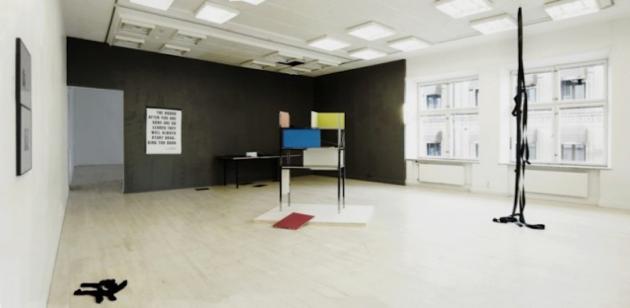Building on its regional program, Garage will open its first exhibition on New Holland Island in St Petersburg. The exhibition runs from August 27 until September 25 in the park’s temporary exhibition space, Pavilion. The Garage Museum of Contemporary Art and “New Holland: Cultural Urbanisation” will join forces to present the group exhibition, “Experiences of the Imaginary,” which showcases the works of recipients of Garage’s grant program for the support of emerging Russian artists.
Nine emerging Russian artists – Nikolai Alexeyev, Aslan Gaisumov, Yevgeny Granilshchikov, Ilya Dolgov, Anastasia Kuzmina, Kirill Makarov, Ivan Novikov, Alexandra Sukhareva, and Anna Titova – will give the audience a glimpse of their inner worlds, as they try to define the place of the artist in the contemporary world, through the prism of personal experience and inner feelings.
In the rapidly changing reality, the professional life of artists is bound up in an endless articulation and struggle for representation in virtual space. This is why curator Andrey Misiano decided to draw attention instead to the interior state of the artist and take a closer look at feelings, rather than the strictly analytic or formal elements of the artistic process. At first glance, this approach might seem conservative, taking us back to the classical perception of the artist as the lone genius, slaving away in the quiet of his studio. At times, it may seem like the art of the 20th century has given way to manifestos, political or social critique, or research projects. But despite these external changes, art remains as before, a holistic practice generating space for sensual encounters and the creation of empirical models of knowledge. In the selected works, the artists in this exhibition each consider the phenomenon of interaction between the outer environment and inner feelings.
For his series, Encounters, 2016, Nikolai Alexeyev seeks out the beauty in everyday life. From the general mass of objects and events, he picks out the most unexpected things and invests them with a certain symbolism: like for instance, a rickety old chair with a ribbon tied to it, or the patterns on ceramic tiles, quite ordinary and all pretty much alike, but also very dear to the hearts of those who remember these tiles from life in the Soviet Union.
The intensity in the life and labor of the artist in a rapidly changing world reflects in the work of Anastasia Kuzmina. Her multimedia installation, Search Engine Malik (2016), riffs on the search for one’s place in a new city and the process of overcoming feelings of alienation.
Yevgeny Granilshchikov approaches the same topic of cities from a different perspective. His new work, Untitled (2016), a geometric architectural object made from transparent glass, pushes the hypothesis that memories and feelings constitute the substance that makes up the image of a city. In this case, you could say that the interior glass space is not empty, but rather just waiting for the events that will fill it with unique imagery.
Ivan Novikov turned his sights on St Petersburg – and New Holland Island in particular – for his work Đà Nang, I Will Be Out in the Rain (2016), which was specially created for this exhibition. The artist produces a series of historical and cultural parallels between the projects of Russia’s pivot towards European modernity – the city and the island – and Đà Nang, one of the largest cities in Vietnam, whose traditional architecture started to see incursions of Western modernism during the 20th century.
Ilya Dolgov’s interest lies in the natural world. He continues to develop his ongoing series, Herbarium (2012-), which explores interaction with the outside world, while also referring to the interior space of the artist. For Dolgov, the gathering of plants or jotting down observations on fauna is akin to a kind of meditation.
Anna Titova’s work, The Last Colony (2016), questions the conditions of existence in a postglobal world. The configuration of the piece, which brings together five different shells, engenders a sensation similar to the feeling one gets from reading J.G. Ballard’s novel, The Drowned World, which imagines the demise of civilization.
In his practice, Kirill Makarov conducts experiments that challenge the canons of painting. For instance, he studies the synthesis of screen printing and painting, or the underlying principles of computer modeling of the body. His piece, Vortices in Sandboxes (2016), bears witness to how advanced technology is still very human at its core, requiring communication with other people.
Aslan Gaisumov’s latest work in his “Manuscripts” series, triptych Untitled (2016), touches on the merging of the object and its history, an analysis of sensations the memories associated with objects, and an attempt to comprehend what has been lost. By attempting to inscribe bits of reality within the museum, the artist is fixing them in the memory of a fleeting moment, beyond retrieval.
Work within the semantic field lies at the heart of Alexandra Sukhareva’s ongoing series, Bracket (2012-), which has the artist leaving a small construction bracket (Between Two Pleasures, 2016) in the structure of different historical and architectural monuments. This spare, almost invisible gesture yields a particular choreography of meanings. Sukhareva “does not destroy the object and does not restore it”; all she does is slightly undermine its foundations, subjectively correcting the vision projected. For New Holland Island, Sukhareva has placed one of these brackets at the base of the big archway, which will be temporarily blocked from view until the reconstruction work is completed.
Photo: Anna Titova Courtesy Calvert

